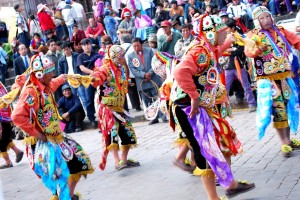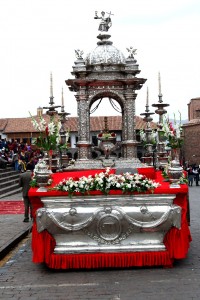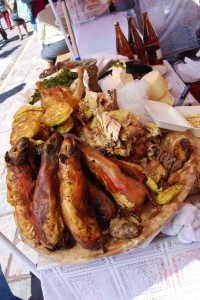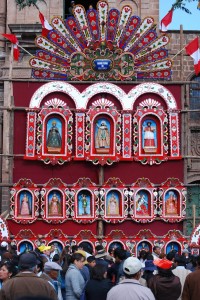Corpus Christi Begins

Two major events will energize Cuzco this month. At the end of the month falls the pageant of Inti Raymi and, in the first week of the month falls the important feast of Corpus Christi. Today the almost non-stop celebration begins.
These two events, along with the procession of the Lord of Temblors in Holy Week, are the three events that most thoroughly involve the city’s population and institutions. Despite being separate, with two officially Catholic and one secular and civic, nonetheless they are historically related as they draw from the Inca past.
Today 15 saints, from the neighborhoods of Cuzco, will lead processions from their chapels to the Plaza de Armas and the Cathedral in which they will spend the night in order to make a grand procession tomorrow. The processions not only include the Saints carried on the backs of faithful and accompanied by the members of their cofradías, brotherhoods, they also include dance troupes filled with devotion and indigenous history. Almost everybody, in one way or another, will be caught up in this celebration.
The historian Carolyn Dean, in her book, Inka Bodies and the Body of Christ, describes how once the Catholic feast of Corpus Christi–which celebrates the Holy Host, was introduced to Cuzco by the Spanish authorities it became a vehicle in which the descendants of the Incas could continue old customs and rituals under the guise of Christianity. Although the official version of the feast is that the “pagan” elements in it are there to demonstrate the power of Christianity to bring even the outsiders to God, for the people of Cuzco the mere performance of old ways helped keep them alive and vital.

Dean notes that Cuzco’s favorite son, Garcilaso Inca de la Vega, who was the son of an Inca noblewoman and a Spaniard, wrote about Inti Raymi as he knew it in the early days of the Conquest and as he was told it used to be. He then uses much of the same language to describe Corpus Christi.

Not only is this because of the ways old ways were embedded in the Christian feast, but it is because Corpus Christi tends to fall in June or close to it, when Cuzco would roll with its great feast of the Sun, its main deity, called Inti Raymi. And, arguably, Corpus Christi is the historical continuation of the old feast, even if now in Christian form.
The new Inti Raymi, performed at the end of this month, was created around the middle of the twentieth century by Cuzco elites as a secular revival of the old, without the Church, based on Garcilaso’s writings. This is the new Cuzco, secular and neo-Inca that shares a month with the old, deeply Catholic Cuzco that carries the Inca carried.
We could easily focus on the native aspects of this feast, but the Catholic is especially important for its devotees. Or we could, like the Church and much of official Cuzco, speak only about the Saints and their Catholic devotion, but in this we would miss the other stories, the other pasts, that are carried in the Saint’s bodies as they parade like so many Inca mummies around the city, the ways they fit into Andean traditions, or their dress and devotion. The official also ignores the great importance of the cargos, the sponsors of the feast, as something that draws on the native ethic of ayni, or reciprocity, as it also ignores the very powerful Indian stories of the dances and the importance of the dance troupes in the feast for making it holy.
Both extremes are, at best, partial. Today’s Corpus Christi is Christian at the same time it is Inca and tack between in different ways for each devotee. Like the mixed and contentious history of the city, this feast–unlike the purified, contemporary Inti Raymi–is the product of centuries of working through what it means to live in this land that has a strong indigenous past and has lived the strong engagement of the Catholic Church with that past as it built a Catholic Cuzco.

Today is called the entrada, or entrance, as each of the saints wends is way in slow, stately procession through the city streets. They are carried on heavy litters by devotees who have been preparing for this even for some time now in social gatherings and feasting.
In their path music marks the saints and devotees path. The sponsor of the feast has contracted a band or bands to fill the air with the sound of appropriate melodies as the bearers of the saint lift it and carry it slowly and meaningfully forward. In addition, dancers dressed in meaningful local costumes will follow the path of the saint in movements that are a kind of indigenous prayer to the saint by drawing it into the whirling wind of life, at the same time they are religious vows of devotion.
The dances themselves portray histories and dramas, often ones that are not fully subordinate to Christianity, even though the dancers perform in spaces made available by the Saints and their stories. (We will publish more on these dances later.)
Once the saints are inside the massive Cathedral, where they will spend the night, people say they gossip with one another telling of the events of their neighborhood and even engaging in the kinds of jealousies that sometimes break out in family gatherings as one sibling show pique with another. They say that the saints even dance to the sound of the bands.
Outside the music continues into the night, a cacophany of different bands, as the sponsors attached to each saint and their followers gather in front and to the side of the Cathedral to eat and drink and dance.

Tomorrow, the Holy Sacrament will leave the Cathedral on a very ornate, silver litter to make the rounds of the plaza. Once it has reentered the Cathedral, the various saints will also leave to make rounds and visit the elaborate altars, raised by the city’s organizations, where the saints will pause before continuing their path. Again they return to the Cathedral where they spend the week.
A week of civic celebrations, parades, and dance troupes now begins in which most of the cities institutions and large numbers of its people will take their turns performing before the Cathedral with its enclosed Holy figures on their litters. At the end of the week, on the octave, the Saints begin their slow return to their home chapel in elegant procession through the city.
During the festivities the people of Cuzco will consume chiriuchu, a cold dish that draws the world together. For those who wish, it will be served at various stands set up in the city, as well as in local restaurants. They will also drink aguardiente, or an infusion of cane alcohol with herbs. (See Rosario Olivas Weston).

With the Saints enclosed once again in their neighborhood churches, the celebration continues in many of Cuzco’s neighborhoods. But the main square prepares for the massive pageant of the contemporary Inti Raymi which will take place there, as well as at the Qori Cancha (temple of the sun, contemporary Santo Domingo) and Saqsayhuaman. The great month of celebration has truly begun while the sun is at its weakest point prepares to get stronger and lengthen days again.

Further reading:
Carolyn Dean, The Inka Bodies and the Bodies of Christ: Corpus Christi in Colonial Cuzco, Peru. Duke University Press, 1999.
Max Harris, Saint Sebastian and the Blue-Eyed Blacks, Corpus Christi in Cusco, Peru, TDR Vol. 47, No. 1 (Spring, 2003), pp. 149-175.




